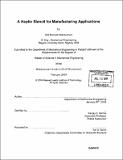| dc.contributor.advisor | Sanjay E. Sarma. | en_US |
| dc.contributor.author | Mansukhani, Kirti Ramesh, 1981- | en_US |
| dc.contributor.other | Massachusetts Institute of Technology. Dept. of Mechanical Engineering. | en_US |
| dc.date.accessioned | 2005-09-06T21:25:18Z | |
| dc.date.available | 2005-09-06T21:25:18Z | |
| dc.date.copyright | 2004 | en_US |
| dc.date.issued | 2004 | en_US |
| dc.identifier.uri | http://hdl.handle.net/1721.1/27037 | |
| dc.description | Thesis (S.M.)--Massachusetts Institute of Technology, Dept. of Mechanical Engineering, 2004. | en_US |
| dc.description | Includes bibliographical references (p. 86-90). | en_US |
| dc.description.abstract | The haptic stencil consists of a 5 DOF haptic device and an anti-collision algorithm that acts as a geometric stencil and can be used for a variety of applications ranging from training to rapid prototyping and manufacturing. Online manipulation of a three-axis desktop milling machine was established using this setup. This work describes the algorithm design used to achieve the required performance and stencil-like behavior with specific reference to machining applications. Some of the primary aspects of this design include the collision detection, collision remediation and control methodologies employed. The parameters on which these methodologies depended and how they were developed are the focus of this work. Collision detection is the core of any haptic interaction as it determines whether or not contact has been established between the virtual objects and therefore is essential in deciding the appropriate haptic feedback. In the case of the haptic stencil, the collision detection algorithm would have to identify whether or not contact occurs between the haptic probe-controlled tool object and the stationary part object. Collision remediation provides the stencil-like behavior by enforcing geometric constraints on the regions/surfaces by preventing penetration by the tool object. The results from the collision detection and collision remediation modules are used to control the desktop milling machine which cuts out a copy of the part object used in the haptic simulation from a given stock according to the motions specified on the haptic probe by the operator. Speed control is necessary in order to ensure that motions from the human operator are not lost due to the different communication speeds between the various modules of this setup. | en_US |
| dc.description.abstract | (cont.) Speed control also helps in providing as 'real-time' a machining experience as possible for a given part and stock combination. | en_US |
| dc.description.statementofresponsibility | by Kirti Ramesh Mansukhani. | en_US |
| dc.format.extent | 90 p. | en_US |
| dc.format.extent | 4184095 bytes | |
| dc.format.extent | 4194070 bytes | |
| dc.format.mimetype | application/pdf | |
| dc.format.mimetype | application/pdf | |
| dc.language.iso | en_US | |
| dc.publisher | Massachusetts Institute of Technology | en_US |
| dc.rights | M.I.T. theses are protected by copyright. They may be viewed from this source for any purpose, but reproduction or distribution in any format is prohibited without written permission. See provided URL for inquiries about permission. | en_US |
| dc.rights.uri | http://dspace.mit.edu/handle/1721.1/7582 | |
| dc.subject | Mechanical Engineering. | en_US |
| dc.title | A haptic stencil for manufacturing applications | en_US |
| dc.type | Thesis | en_US |
| dc.description.degree | S.M. | en_US |
| dc.contributor.department | Massachusetts Institute of Technology. Department of Mechanical Engineering | |
| dc.identifier.oclc | 56793211 | en_US |
